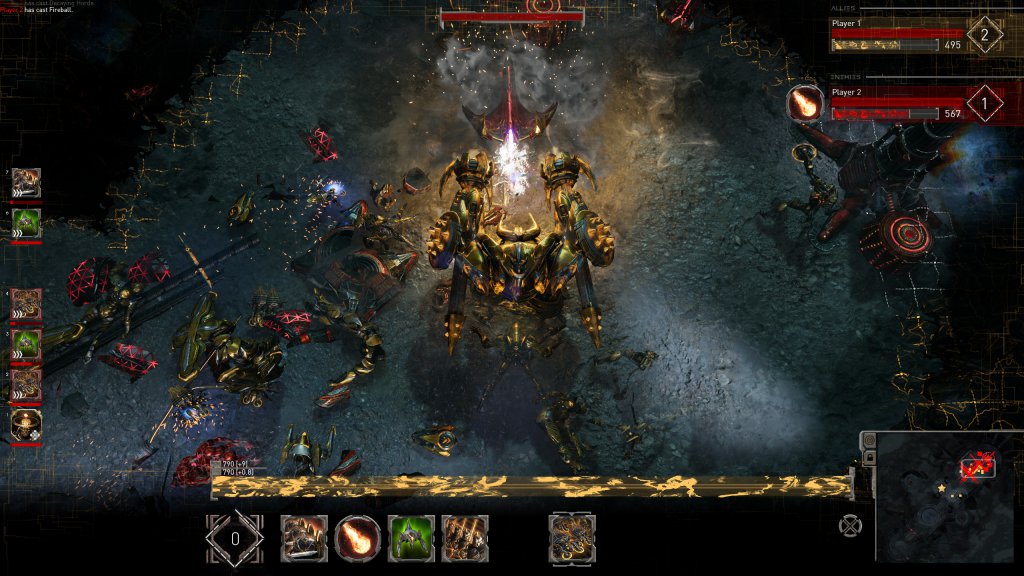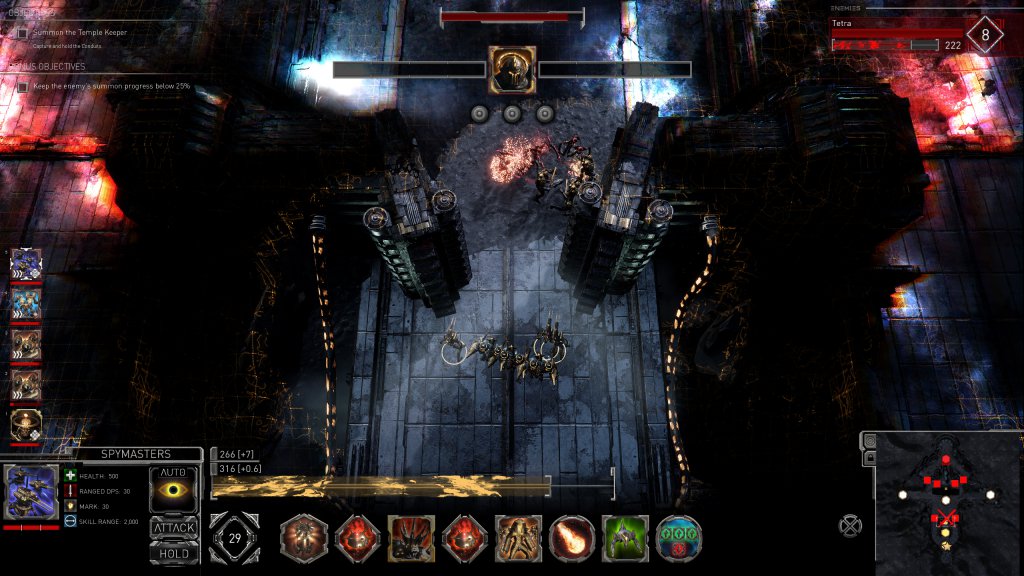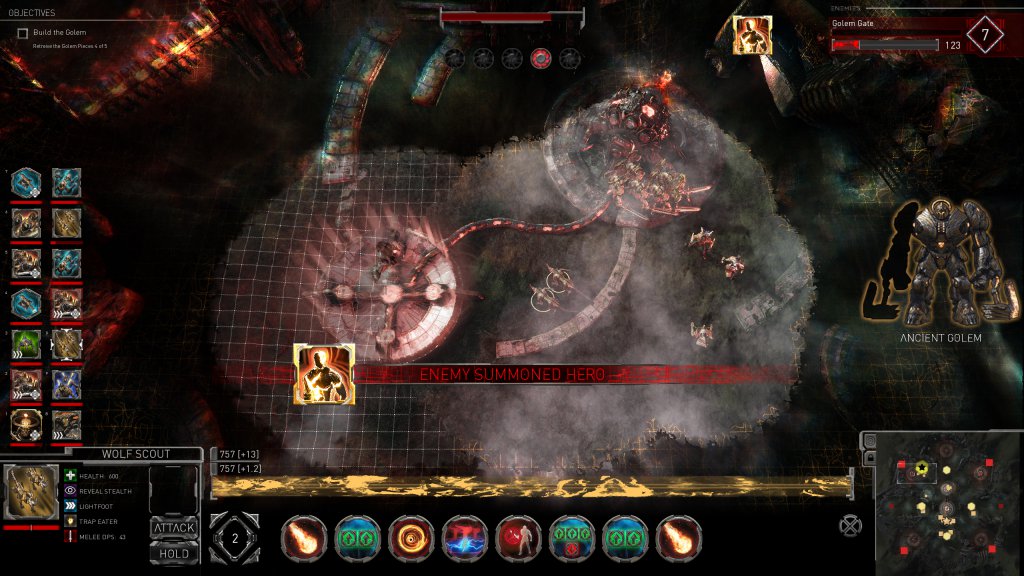Golem Gates review — Card game tactics
In the many years since the rise of collectable card games, spearheaded by Magic: The Gathering, the genre has made its way to computers and consoles. Many of these games simply remove the physical component, whereas others combine the concept with something else entirely. One such game is Golem Gates, developed by Laser Guided Games, marrying card collecting with real-time strategy.
Golem Gates is set in an alien world covered in Ash and ruled by tyrants. You take the role of the Harbinger, an individual who can harness the remnant power of the Ash. Guided by what appears to be a sapient sun, you command an army of warriors to restore your broken world — primarily, but not exclusively, by tearing down the titular Golem Gates.
The Harbinger, your avatar, is a powerful creature, but at the same time is also your primary weakness as a player: Losing him ends the game. Thus, the majority of the fighting is done by your underlings. These warriors are summoned via glyphs, Golem Gates’s card analogue, and commanded in the fashion of a real-time strategy game. In addition to that, glyphs can also create static defences and traps on the battlefield, buff units or cause direct damage in one form or another. You start a match with only five glyphs in your hand, but more are added after a set amount of seconds have passed.
Using a glyph requires energy, represented by an ever-filling meter at the bottom of the screen. At the start of a match, the energy meter has not reached it full extent — something which can be achieved with a little tact. Letting it fill and, as such, expand allows you to use more powerful glyphs while also preventing you from starting a match by summoning your best creatures. In order to speed up the process, power generators scattered across the map can be captured.
In the beginning, Golem Gates hands you a starting deck with a mix of units, traps and buildings. Additional glyphs are earned after matches against the AI or other human players. These glyphs are handed out at random. However, Golem Gates also awards you with points. These points can be used to buy glyphs, giving you a little more control over what glyphs will enter your deck next.
Interestingly, there is no fixed amount of glyphs required for a player deck. You are free to fill it up with every glyph in your collection, reducing the chance that a top glyph appears, or create a small deck and burn to it in quick fashion. Once all glyphs are gone, the game is not over. The Harbinger can hibernate for fifteen seconds and give you fresh deck. However, no commands can be issued during this time period, leaving you highly vulnerable.
The core of Golem Gates is the competitive multiplayer mode: Two players go up against one another, and whoever slays the opponent’s Harbinger first wins. Alternatively, you can go up against computer opponents with a number of different personalities and difficulty levels. There is also a survival mode in which you have to hold out against wave after wave of enemies for a set amount of time. If that is not enough, Golem Gates’s trial mode gives you a number of challenges with specific conditions, like a map where the enemy Harbinger cannot be reached directly and units have to be summoned across a chasm.
Lastly, there is the single-player campaign, which consists of fifteen missions with various objectives. Between missions, you are treated with cryptic messages about the future of your world as well as threats by your enemies. No intricate storytelling or character development should be expected here, but the campaign does set the tone, and strengthens Golem Gates’s bleak atmosphere.
Equally bleak is the game’s visual representation. The graphics are quite detailed, but consist mostly of grey backgrounds with some muted colours thrown in. Additionally, the sight radius of most units is quite small. As a result, the fog of war darkens the majority of the already dark maps. This impacts the gameplay as well: Many creatures are hard to distinguish in the midst of a skirmish and blend together, especially when they come as part of a squad. Squads of units also suffer from pathfinding issues. Sometimes one member gets stuck and forces the rest to a halt. Other times a single units decides to take a completely different path than the rest or makes a circular move to a destination which would have been reachable in a straight line. Both of these issues hamper unit micromanagement.
Graphical and technical issues aside, randomness is both the greatest flaw and feature that Golem Gates possesses. Due to its nature as a card game hybrid, you have to rely on luck up to a certain degree. At the beginning of a match, the game displays five of your starting glyphs and offers you the opportunity to swap them out against other random glyphs.
This gives you limited control over your starting hand. However, this still does not guarantee that you start the match with enough resources to expand or attack. Should your opponent manage to capture generators more quickly. thanks to a strong hand, the tide of battle can turn quickly in their favour while you never recover from your initial misfortune.
Equally random are the glyphs gained after each match. The aforementioned glyph purchase mechanic mitigates this somewhat, as does the total number of different cards, which is under a hundred. The developers also had the foresight to limit the number of copies of the same glyphs you can get — you will not end up with a dozen copies of a glyph you never liked in the first place.
Nevertheless, a limited or poor selection of glyphs not only means that you lack the edge in battle, but also gates off one of the most interesting parts of the game — deck building. Would you like to flood the battlefield with cheap units, build lots of structures or focus on highly-buffed unique summons? The choice is yours — provided you have the glyphs to build the deck you want.
Repeatedly fighting easy AI opponents to gain glyphs is straightforward and not very difficult, but not very exciting. More entertaining are matches against other humans, provided there are any such matches available. The player base of Golem Gates throughout early access has been quite small, which is unfortunate, and many of the dedicated players are veterans, which raises the barrier of entry for new players.
Overall, Golem Gates is a game that takes old ideas and mixes them together to create something fresh. It offers a number of different modes and a high degree of customisation. However, its randomness can be frustrating at times, and unlocking the game’s full potential takes longer than you might be willing to give it.
Golem Gates is now available for PC vis Steam.




Comments are closed.